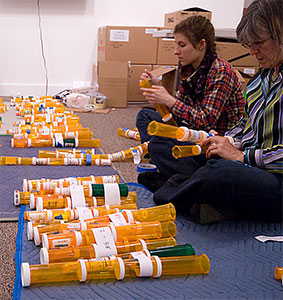Gibbs and chemical processes


Chemical Balance
- by Jean Shin
Chemical process: thermodynamic process
We can think of chemical processes as thermodynamic processes as well. In any chemical reaction, say, the combustion of methane... $$CH_4 +2O_2 \to CO_2 + 2 H_2O$$ There is an initial state (the reactants) and a final state (the products).
There is a difference in the internal energy of the system, $\Delta U$, between the final state and the initial state. Similarly, $\Delta H$, or $\Delta S$.
Much of GChem takes place in open containers: $T$ is constant, and close to room temperature, $P$ is constant and close to 1 atm. When heat is given off at constant pressure, the heat corresponds to a change in enthalpy (not internal energy).
The heat given off in the reaction above is
$$\Delta H^o= 55.5 \text{ MJ/kg},$$ where the superscript '${}^o$' indicates "standard conditions":
- The reaction has gone to completion,
- Initial conditions of reactants: room temp and 1 atm,
- Final conditions of all products: room temp and 1 atm,
- pure substances.
Gibbs potential under 'standard conditions'
For any thermodynamic process to happen spontaneously, it must be the case that the total entropy (system + surroundings) increases, that is $$0 \lt \Delta S_{\text{total}}=\Delta S_{\text{surroundings}}+\Delta S_{\text{system}}.$$
If there is positive heat flow $\left[\Delta Q_r\right]_P=\Delta H_{\text{system}}$ in to the system, then, the entropy of the surroundings drops by an amount $-\Delta H_{\text{system}}/T$.
Substituting this into the expression above, and multiplying by $-T$: $$0 \gt -T\Delta S_{\text{total}}=\Delta H_{\text{system}} -T\Delta S_{\text{system}}.$$
Writing $G=H-TS$, for a constant $T$ process, the differential becomes $dG=dH-T\,dS$. [* Why no $S\,dT$ term? Re-examine those "standard conditions" assumptions...]
The right-hand side of the expression is precisely $\Delta G_{\text{system}}$, and from what we've written, apparently $-\Delta G_{\text{system}}/T=\Delta S_{\text{total}}$, and for spontaneous processes, $$0 \gt \Delta G$$ Therefore...
For constant $T$, constant $P$ conditions:
$$ \Delta G \lt 0 \Leftrightarrow \Delta S_\text{total} \gt 0 \Leftrightarrow
\text{spontaneous process}$$
Huge advantage: $G$ is a function of system variables alone, so we can know if a chemical reaction will proceed spontaneously without explicitly calculating the change of entropy of the surroundings.
From here on, we drop the 'system' subscript, as understood, and just write $$\Delta G = \Delta H -T\Delta S.$$
Hess' Law
We can travel from the initial state of a chemical process to the final state by several different chemical paths. But because a quantity like the enthalphy is a state variable the total change $\Delta H$ only depends on the initial state (reactants) and the final state (products), therefore... $$\begineq CH_4 &\to&C+2H_2&\Delta H_1\\ C+ O_2 &\to& CO_2 & \Delta H_2 \\ 2*(H_2+1/2\,O_2) &\to& 2*H_2O & \Delta H_3 \\ \\ \\ CH_4 +2O_2 &\to& CO_2 + 2 H_2O \ \ & \Delta H=\Delta H_1+\Delta H_2+\Delta H_3 \endeq$$
The heat of formation under standard conditions, $\Delta H_f^o$ of a compound is the heat released when 1 mole of that compound (at room temp and 1 atm) is produced from the most common form of its elements (at room temp and 1 atm). $$\begineq CH_4 &\to&C+2H_2&\Delta H_1= -(\Delta H_f)_{CH_4}\\ C+ O_2 &\to& CO_2 & \Delta H_2 = (\Delta H_f)_{CO_2}\\ 2*(H_2+1/2\,O_2) &\to& 2*H_2O & \Delta H_3 = 2*(\Delta H_f)_{H_2O}\\ \\ \\ CH_4 +2O_2 &\to& CO_2 + 2 H_2O \ \ & \Delta H=\Delta H_1+\Delta H_2+\Delta H_3 \endeq$$
The usefulness of these heats of formation is that, instead of compiling $\Delta H$ for many, many reactions, we can just compile the heats of formation from the elements, and then use them to calculate the heats of any desired chemical reaction.
Under standard conditions, we can write... $$\Delta H_r^o = \sum_{\text{products}}\Delta H_f^o -\sum_{\text{reactants}}\Delta H_f^o$$
We can play the same game to find the reaction Gibbs energy in terms of the formation $\Delta G_f^o$ of the individual compounds in the reaction.
Now we are in a position to be able to judge whether a chemical reaction may proceed spontaneously or not,
In our culture, does spontaneous means, "in the inevitable direction of the heat death of the universe"?

Ahem... Now we are in a position to be able to judge whether a chemical reaction may proceed spontaneously or not, because we can calculate a standard Gibbs free energy difference between the products and reactants in any reaction from tabulated standard values like this: $$\Delta G_r^o=\sum_{\text{products}}\Delta G_f^o -\sum_{\text{reactants}}\Delta G_f^o$$
- if $\Delta G_r^o \gt 0$, the reaction will not take place spontaneously.
- if $\Delta G_r^o \lt 0$, the reaction *can* take place spontaneously, though this doesn't mean that it will...
Is this reaction 'spontaneous'? $$CO(g)+ NO(g) \to CO_2+\frac{1}{2}N_2(g)$$
| $\Delta G_f^o$ | |
|---|---|
| $CO(g)$ | -137 kJ/mole |
| $NO(g)$ | +87 |
| $N_2(g)$ | 0 |
| $CO_2(g)$ | -394 |
- Using these values, calculate $\Delta G_r^o$. You should find that this *is* a spontaneous reaction.
show / hide$$\begineq \Delta G_r^o&=\sum_{\text{products}}\Delta G_f^o -\sum_{\text{reactants}}\Delta G_f^o\\ &=\left(1 \Delta G_{f\ CO_2}^o + \frac12 \Delta G_{f\ N_2}^o\right) - \left( 1 \Delta G_{f\ CO}^o + 1 \Delta G_{f\ NO}^o \right) \\ &=(-394+\frac12 0)-(-137+87) = -344 \text{ kJ/mole} \endeq $$ - Unfortunately, a pure mixture of $CO$ and $NO$ at standard conditions will not change.
- Fortunately if we put the right kind of catalyst (including platinum) in an imaginatively named "catalytic converter", the reaction *will* take place, without the need to supply extra energy.
Answer is = -344 kJ/mol.
Ideal gas
Problem 9-2, b (paraphrased): For an ideal gas, for constant temperature processes, how does the Gibbs energy depend on pressure?
We know (Table 8-1) that $$dG=-SdT+VdP$$
So, if temperature is constant $$[dg]_T=[d\mu]_T=vdP=RT\frac{dP}{P}$$ Integrating, we get the answer to Problem 9-2,b. $$[\Delta g]_T=g(P)-g(P^o) = RT\ln\left(\frac{P}{P^o}\right)$$S
Since $P^o = 1$ atm, you may see this relation written as
$$g(P)=g^o +RT\ln P=\mu_o+RT\ln P$$ Carter says, "This expression is of great use in chemistry"(!)
Equilibrium constant for a chemical reactions
A prototypical chemical reaction: $$aA+bB\to yY+zZ$$
The Gibbs energy difference for the reaction under standard conditions can be calculated from the formation energies... $$\begineq\Delta G_r^o&=y\Delta G_f^o(Y)+z\Delta G_f^o(Z)-a\Delta G_f^o(A)-b\Delta G_f^o(B)\\ &=y\mu_Y^o+z\mu_Z^o-a\mu_A^o-b\mu_B^o \endeq $$
Mixture of ideal gases
If we have a mixture of gases of arbitrary composition, we can still write an expression for the reaction Gibbs energy, still at the same (room) temperature, but with different partial pressures, using our newly minted expression for the chemical potential $\mu$ of an ideal gas, away from standard pressure: $$\begineq\Delta G_r &=y\mu_Y+z\mu_Z-a\mu_A-b\mu_B \\ &=(y\mu_Y^o+yRT\ln P_Y) +(z\mu_Z^o+zRT\ln P_Z)\\ &\ \ -(a\mu_A^o+aRT\ln P_A) -(b\mu_B^o+bRT\ln P_B) \\ &=y\mu_Y^o+z\mu_Z^o -a\mu_A^o-b\mu_B^o\\ &\ \ +RT\ln P_Y^y+RT\ln P_Z^z-RT\ln P_A^a-RT\ln P_B^b\\ &=\Delta G_r^o + RT\ln\left(\frac{(P_Y)^y(P_Z)^z}{(P_A)^a(P_B)^b}\right) \endeq$$
If we randomly throw reactants and products together, they will almost never be at equilibrium. But, we know that equilibrium should occur when the Gibbs energy is not changing, $\Delta G_r=0$.
Setting this equal to zero, and solving for the quantity in $\left(...\right)$ gives... $$\frac{(P_Y)^y(P_Z)^z}{(P_A)^a(P_B)^b} = e^{-\frac{\Delta G_r^o}{RT}}=K(T).$$ This is the equilibrium "constant" at a particular temperature in terms of partial gas pressures of the reactants at equilibrium.
Furthermore, we could express that exponential as... $$e^{-\frac{\Delta G_r^o}{RT}}=e^{-\frac{\Delta H_r^o-T\Delta S_r^o}{RT}}= e^{-\frac{\Delta H_r^o}{T}}e^{\frac{\Delta S_r^o}{R}} .$$
So, at low temperatures, chemical reactions are driven to the side of the equation that has the lowest enthalpy. But at higher temperatures the entropy term dominates, and the reaction is driven towards the side of the equation which has the greater entropy.
Preview of things to come
How to think about entropy in chemical reactions?
- We shall see that entropy can be thought of in terms of how certain we are about the state that a system is in.
- Spontaneous changes happen in the direction of greater entropy (more uncertainty about the state of the system).
- In QM terms we can specify the state of a system in terms of an energy level diagram with dots indicating which energy levels are occupied.
- These guys do a nice job of visually connecting spontaneity in chemical reactions with spacing of energy levels in products and reactants..